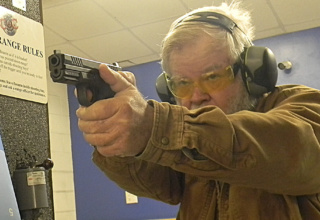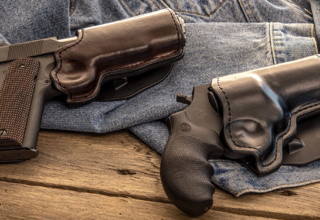Experienced shooters know there is no single path to improving the accuracy of a rifle. Many variables contribute to the ultimate goal of repeatable point-of-impact. High among these variables are barrel construction, action stability, cartridge load, stock fit and ergonomics…the list goes on. All are important, of course, but given a good overall-performing factory rifle, there is one item that can help you achieve tighter groups probably quicker than anything else, and that is a better trigger.
Factory triggers tend to be one of the glaring weak links in the accuracy chain. It’s not that they are poorly designed or don’t work well (in most cases), they just don’t work as well as they should for the discerning shooter. Common problems with factory triggers include heavier-than-necessary pull weight, a rough or “crunky” trigger-to-sear engagement surface, and excessive “creep,” which is basically any rearward, or positive, movement of the trigger (in a conventional single-stage trigger) between the time the trigger causes the sear to move and the moment the sear releases the striking mechanism (called the break).

Why are any of these conditions a problem? Because they can all lead to potential disruption of the shot, which contributes to inconsistent point-of-impact.
Talk to any pro shooter and they’ll tell you that smooth trigger travel (one that exhibits no roughness or “steps” that interrupt movement) and a crisp trigger break (where the trigger goes from not moving to BANG under steady pull) is almost always the goal in a precision rifle setup. Anything less invites trouble because time, applied force, and body geometry can disturb sight alignment if the trigger isn’t smooth and the break isn’t crisp.
For these reasons, installing a trigger that exhibits smooth travel, has a relatively lighter pull than a stock trigger, and that quickly and cleanly releases the sear will allow you to shoot most any rifle more consistently. And consistency in shot placement is the very definition of accuracy.
Fans of the famed Ruger 10/22 rifle know all too well that, while the rifle is an exceptional performer out of the box, the trigger is nothing to brag about. In fact, it’s a far cry from being OK in the eyes of even moderately serious shooters. That can present a real accuracy problem in a rifle platform that is already light in weight and nimble in handling. Given that the stock 10/22 trigger breaks at around six pounds, it’s easy to understand how this unrefined trigger performance can upset a shot.
 A couple years ago, we bought a new 10/22 with the intention of creating the ultimate squirrel rifle. Step One involved ditching the plastic stock for a more substantive yet lightweight laminated hardwood stock. We selected a Boyds SS Evolution for its minimalist approach and pistol grip configuration, then swapped the barrel for a fluted and suppressor-threaded model from Green Mountain Rifle Barrel Co. After adding a 3-9X Crossfire II optic from Vortex, the combination shot like a champ, delivering reliable dime-sized groups at 50 yards. For woodland squirrel plunking, it doesn’t get much better except…that darn trigger. Heavy, crunky, and creepy. We could put up with it on the bench, but in the field, the problems magnified.
A couple years ago, we bought a new 10/22 with the intention of creating the ultimate squirrel rifle. Step One involved ditching the plastic stock for a more substantive yet lightweight laminated hardwood stock. We selected a Boyds SS Evolution for its minimalist approach and pistol grip configuration, then swapped the barrel for a fluted and suppressor-threaded model from Green Mountain Rifle Barrel Co. After adding a 3-9X Crossfire II optic from Vortex, the combination shot like a champ, delivering reliable dime-sized groups at 50 yards. For woodland squirrel plunking, it doesn’t get much better except…that darn trigger. Heavy, crunky, and creepy. We could put up with it on the bench, but in the field, the problems magnified.
Time to get rid of that. Fortunately, the aftermarket has many high-end triggers to choose from—triggers that solve all the inherent problems with the 10/22’s factory unit. The only downside is the cost. With prices spanning the $200-$300 range, it’s tough for regular folks like us to justify an upgrade such as this unless we intend to get super-serious about competitive shooting.
Several years ago, however, Ruger decided to address their 10/22 trigger issue by developing a drop-in replacement. Called the BX-Trigger, this fully self-contained unit secures in place of the factory trigger on any Ruger 10/22 rifle or 22 Charger pistol. The BX-Trigger is a fraction of the cost of most aftermarket triggers at its $89.95 MSRP, but the street price is around $20 less than that.
The BX-Trigger is noticeably smoother than the stock trigger, with a much cleaner break and slightly reduced over-travel. All these characteristics combine with a significant reduction in trigger pull weight. Whereas the stock trigger pulls around six pounds, the BX-Trigger pulls in the neighborhood of 2.5 to 3 pounds. That’s much more in line with what we would expect from a performance-oriented trigger—light enough to minimize shot disturbance yet heavy enough for safe operation in a range or hunting environment.
If you are uncomfortable with the idea of taking your 10/22 apart and swapping something as fundamental as a trigger system…don’t be. Even if you have never worked on a gun before, you’ve got this. One screw and two pins are all you need to touch to remove the original unit and install the BX-Trigger. Follow along as we show you how simple the job is…

Before working on the rifle, ensure it is in a safe condition. Remove the magazine, pull back the bolt, and visually inspect the open chamber to make sure there is no cartridge present.

Using an appropriately sized driver, loosen the action screw until it disengages from the barreled action. You do not need to completely unscrew the action screw from the stock.

Center the safety bar so that each side protrudes equally from the trigger housing. This is to provide clearance to separate the stock from the barreled action.

Separate the stock from the barreled action.

The trigger housing secures to the receiver via two cross pins.

Lay the barreled action right-side down so the charging handle supports the assembly off the bench. Using a punch that is smaller in diameter than the pin hole, push or tap out each pin.

The trigger housing can now be separated from the receiver.

The BX-Trigger comes with a dry-fire block. To remove, pry outward on the dry-fire block front retaining arms and pull the block rearward.

Install the new BX-Trigger into the receiver.

Lay the barreled action on its left side and push or tap the cross pins into place. Once done, reinstall the stock and tighten the action screw.

The last step is to perform a function check to make sure the trigger and safety are working properly. To do this:
1) Make sure there is no cartridge in the chamber and the magazine is out.
2) Point the rifle muzzle in a safe direction.
3) Pull back on the bolt to cock the hammer.
4) Move the safety to ON.
5) Pull the trigger. The trigger should not move rearward.
6) Move the safety to OFF.
7) Pull the trigger. The trigger should move rearward and the hammer should drop.
8) Pull back on the bolt to recock the hammer. Pull the trigger and maintain rearward pressure after the hammer drops. Do not let up on the trigger.
9) With the trigger in its rearmost position, pull back on the bolt to recock the hammer and then release the bolt.
10) Slowly allow the trigger to move forward. You should hear an audible click and feel the trigger as it resets. This concludes the function check.
SPECIAL OFFER!
From now through Cyber Monday (November 26, 2018), you can purchase a Ruger BX-Trigger for only $64.99. Simply follow this link for instant savings!

















